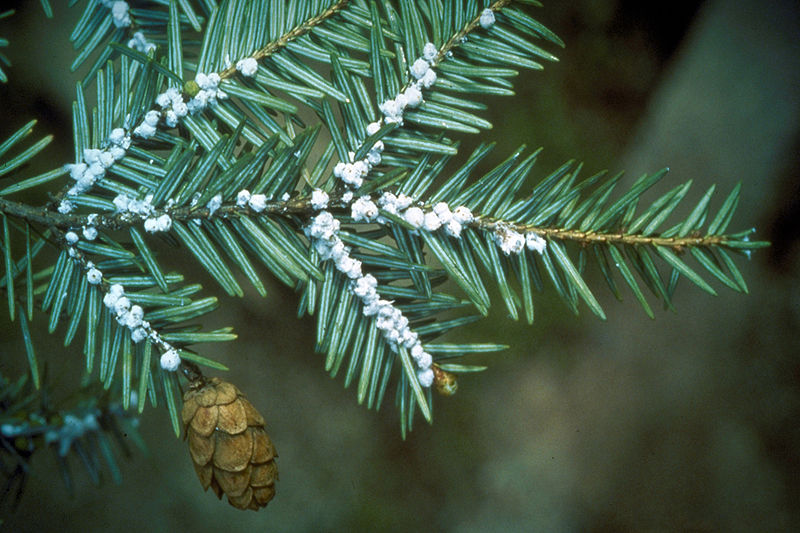However, these difficulties have been overcome in a new study published earlier this month, which utilized advanced mathematical modeling techniques to estimate the total direct annual costs of invasive forest insects in the continental United States. The scientists who conducted the study represent a variety of disciplines from several research institutions, including the National Center for Ecological Analysis and Synthesis, McGill University, the University of Minnesota, the US Forest Service, Arizona State University, Michigan State University, and the University of Central Florida.
(Damage to a hemlock tree by the hemlock woolly adelgid, Adelges tsugae, which feeds on sap.)
(The hemlock woolly adelgid.)
They made use of a database cataloging the 455 nonnative forest insect species known to be established in the US. Each species was assigned to one of 4 feeding guilds based on its primary or most damaging mode of feeding--phloem/wood borers, sap feeders, foliage feeders, or "other." Although invasive insects can have a variety of direct and indirect costs, the researchers focused on those that are best documented and, therefore, easiest to measure accurately: federal government expenditures (on surveying, research, regulation, management, and outreach), local government expenditures (tree removal, replacement, treatment), household expenditures (tree removal, replacement, treatment), residential property value losses, and timber value losses to forest landowners.
(An emerald ash borer, Agrilus planipennis, a "poster pest" from the borer guild.)
Wood borers, often invade by hitching a ride on wood packaging materials shipped from overseas, while sap and foliage feeders probably originate on shipments of live plants. When all spending categories were considered cumulatively, the most economically destructive group was the wood boring guild, despite the fact that this group contained the smallest number of species. These insects cost local governments approximately $1.7 billion and reduced property values by about $830 million. The least harmful group overall was the sap feeding guild, despite the fact that it comprised the largest number of species. These insects caused "only" $14 million in federal spending and $260 million in real estate losses each year. Foliage feeders were intermediate to these two extremes, costing the federal government approximately $110 million per year, and reducing property values by $410 million. For each guild, only the two most costly categories are listed here; each group of insects was also associated with millions more dollars of expenditures by other entities, such as forest landowners.
(A gypsy moth, Lymantria dispar, which originates in Eurasia but has been increasing its range in North America since introduction in the 1860's.)
These estimates emphasize that invasive species can be not just ecologically, but also economically, destructive. Because these figures do not take into account indirect costs, the tallies presented here are just the lower bound of the total cost of forest insect pests. Overall, the bulk of costs were borne by homeowners and municipal governments, whose efforts were focused on removing damaged or dying trees, replacing them with healthier specimens, and/or applying anti-pest treatments. The authors of the study suggest that some of these costs could be offset by targeted import taxes or fees, such that the same people responsible for introducing the pests would also be the ones supplying at least some of the funds used to eradicate or control them.
The data are also useful for evaluating the utility/efficacy of current spending. For instance, although wood borers cause more damage than foliage feeders, the federal government spends similar amounts on efforts to control species from both guilds. Likewise, while sap feeders cause more localized host mortality, they receive less funding than defoliators and borers. These spending "mismatches" do not necessarily represent poor decision-making skills among the powers that be. Rather, they may reflect the difficulty of controlling pests that can be spatially and temporally unpredictable, as well as a lack of regulatory/management options, or even the effects of external pressures (e.g., lobbying) on spending decisions.
The modeling framework developed in the study can be updated as new information becomes available, and can be tweaked to include other ecosystem services--and ecological impacts--as they are increasingly better understood. Hopefully, shareholders, policy-makers, and managers alike can use the results of this and future models to make decisions ensuring that they are spending their money wisely.
---
Aukema, J.E., Leung, B., Kovacs, K., Chivers, C., Britton, K.O., Englin, J., Frankel, S.J., Haight, R.G., Holmes, T.P., Liebhold, A.M., McCullough, D.G., Von Holle, B. 2011. Economic impacts of non-native forest insects in the continental United States. PLoS ONE: 6(9):e24587.
Thanks to the following websites for providing the images used in this post:
http://en.wikipedia.org/wiki/File:Adelges_tsugae_3225077.jpg
http://www.northgeorgia.edu/EnvironmentalLeadership/Default_1col.aspx?id=4294971323
http://www.emeraldashborer.info/
http://www.butterfly-conservation.org/Moth/440/Moth.html?MothId=182




No comments:
Post a Comment